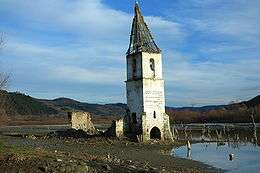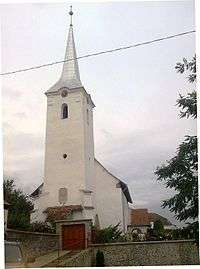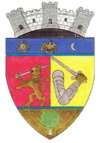Sângeorgiu de Pădure
| Sângeorgiu de Pădure Erdőszentgyörgy | ||
|---|---|---|
| Town | ||
|
Landscape near the town | ||
| ||
 | ||
 Sângeorgiu de Pădure | ||
| Coordinates: RO 46°25′49″N 24°50′30″E / 46.43028°N 24.84167°E | ||
| Country |
| |
| County | Mureș County | |
| Status | Town | |
| Government | ||
| • Mayor | András Tar[1] (Democratic Union of Hungarians in Romania) | |
| Area | ||
| • Total | 71,42 km2 (2,758 sq mi) | |
| Population (2002) | ||
| • Total | 5,492 | |
| • Density | 78/km2 (200/sq mi) | |
| Time zone | EET (UTC+2) | |
| • Summer (DST) | EEST (UTC+3) | |
| Postal Code | 547535 | |
| Area code(s) | +40 265 | |
| Website | Mayor's Office website | |
Sângeorgiu de Pădure (Hungarian: Erdőszentgyörgy, pronounced [ˈɛrdøːsɛnɟørɟ], meaning "St. George of the Forest"; German: Sankt Georgen auf der Heide) is a town in Mureș County, Romania.
Bezid (Bözöd), Bezidu Nou (Bözödújfalu) and Loţu (Lóc) villages are administratively part of the town.
History


The first written record of the town is preserved in a papal tithe applotment list from 1333 in which mention is made of a priest „de Sancto Georgio” [2] who paid a sum of 6 dinars to the neighboring diocese. In 1347, a man named Erdő, count of the Székelys, and the sons of Erdő of Erdőszentgyörgy were mentioned.[2] In 1442, Anna Herepei, wife of Erdő of Erdewzenthgergh is written about.[2] The village was the estate of Francis I Rákóczi, prince of Transylvania.[2] The Rédey castle was built in 1647. In 1788, Péter Bodor was born here.[2] In 1818-1809, the Rédey castle was rebuilt.[2] In 1913, the official Hungarian name of the village is Erdőszentgyörgy.[2]
Its Romanian name was originally Erdeo-Sângeorgiu, after 1919 Sîngeorgiul de Pădure which later was changed by Romanian authorities to the current official name.[2]
In the mid-1780s as part of the Josephine administrative reform, Marosszék was integrated into Küküllő county, however, the szék-system was restored in 1790. After the suppression of the Hungarian Revolution in 1849, the village formed part of the Kibéd military sub-division of the Marosvásárhely division in the Udvarhely military district.[3] Between 1861–1876, the former Marosszék was restored.[3][4] As a result of the administrative reform in 1876, the village fell within Nyárádszereda district of Maros-Torda County in the Kingdom of Hungary.[5] After the Treaty of Trianon of 1920, it became part of Romania and fell within Mureş-Turda County during the interwar period. In 1940, the Second Vienna Award granted the Northern Transylvania to Hungary and it was held by Hungary until 1944. Administered by the Soviet authorities after 12 November 1944, the village, together with the rest of Northern Transylvania, came under Romanian administration on 13 March 1945 and became officially part of Romania in 1947.[6][7] Between 1952 and 1960, the commune fell within the Magyar Autonomous Region, between 1960 and 1968 the Mureş-Magyar Autonomous Region.[3] In 1968, the province was abolished,[8] and since then, the settlement has been part of Mureş County. It became a town in 2004.[2]
The grave of Claudia Rhedey, grandmother of Queen Mary of England, is placed in the crypt of the Reformed church[9] which was renovated in 1936[2] from donation of Queen Mary of England, great-granddaughter of count Rhedey and grandmother of Queen Elisabeth II of Great Britain.British Royal Family.[9]
Demographics
The commune has an absolute Székely Hungarian majority.[10]
In 1900, the village had, in order of population size, 4,131 Hungarian (91,23%) and 352 Romanian (7,77%) inhabitants.[11] In 1930, the census indicated 2,954 Hungarians (61,17%), 1,194 Romanians (24,73%), 334 Jews (6,92%) and 334 Gypsies (6,92%). According to the 2011 census, 3,816 (75,48%) residents reported themselves as Hungarian, while 904 Romanian (17.88%) and 4.74% Gypsy, from a total of 5055 inhabitants. In 2002, 2,121 households were registered in the town along with 1,912 residential buildings.[12]
| Historical population | ||
|---|---|---|
| Year | Pop. | ±% |
| 1850 | 3,354 | — |
| 1880 | 3,882 | +15.7% |
| 1900 | 4,277 | +10.2% |
| 1910 | 4,528 | +5.9% |
| 1930 | 4,829 | +6.6% |
| 1956 | 6,360 | +31.7% |
| 1977 | 5,714 | −10.2% |
| 1992 | 5,715 | +0.0% |
| 2002 | 5,492 | −3.9% |
| 2011 | 5,055 | −8.0% |
| Source: Census data | ||
The 2002 Census reported Calvinism being professed by 54.71% of the total population, while 19.61% of the respondents belonged to the Romanian Orthodox Church, 10.34% of the respondents reported themselves as Unitarian, 8.55% as Roman Catholic and 1.07% as Baptist.[10]
Politics

The local Town Council has 15 members:[13]
| Party | Number of councillors | ||||||||||
|---|---|---|---|---|---|---|---|---|---|---|---|
| Democratic Union of Hungarians in Romania | 9 | ||||||||||
| Social Liberal Union | 5 | ||||||||||
| Hungarian Civic Party | 1 | ||||||||||
Landmarks

- The Rhédey Castle was built in 1759 on the site of a former 16th-century castle. The castle was rebuilt in 1808. This is where Claudia Rhédey, grandmother of Queen Mary, great-great-grandmother of Elizabeth II grew up.
- The reformed church was built in the late 13th and early 14th centuries. The synode of the Unitarian church was held here in 1621 whern the Unitarians officially distanced themselves from the Sabbatarians as ’Judaizers’.[14] It has belonged to the Reformed church since 1640. The church tower was added during the era of the Reformation. The patrons of the church were the Rhédey and Wesselényi families. It was rebuilt and restored in 1760. During a plague, the crypt below the church was closed by a wall by order of Gabriel Bethlen, prince of Transylvania The crypt of the Rhédey family is also in this church. The Rhédey Mausoleum, now in ruins, stands on top of a hill north of the village, this is wherefrom the remains of countess Claudia Rhédey, wife of Duke Alexander of Württemberg was removed into the reformed church in 1841.
- The Orthodox Church was built in 1838 in the place of a former wooden church.
- The town has a synagogue, too.
- The mansion house of the Zeyk family's is from the 16th century. Lieutenant General János Kiss was born in this house.[15]
Notable people
- Péter Bodor, Székely mechanic, was born here in 1788[16]
- Countess Claudine Rhédey von Kis-Rhéde, an ancestor of the British Queen Elizabeth II, was born in the town in 1812.[17]
- Lieutenant General János Kiss, martyr of Hungarian anti-German resistance movement, was born here in 1883 [16]
Twinnings
The town is twinned with:
See also
References
- ↑ Central Electoral Bureau 2008
- 1 2 3 4 5 6 7 8 9 10 János András Vistai. "Tekintő – Erdélyi Helynévkönyv" (PDF). Transylvanian Toponym Book. p. 961.
- 1 2 3 Tibor Elekes. "Marosvásárhely közigazgatási szerepe a XIV. századtól napjainkig" (PDF) (in Hungarian). p. 1, figure 3.
- ↑ Gazeteer of Hungary, 1873
- ↑ Hungarian Administrative Reform Act 1876
- ↑ Sălăgean, Marcela (2002). The Soviet Administration in Northern Transylvania (November 1944 March 1945). Boulder, CO: East European Monographs. p. 190. ISBN 0-88033-496-7.
- ↑ Zoltán Mihály Nagy. "Power Changes and Self-administration in Northern Transsylvania 12 November 1944–13 March 1945". Retrieved 2010-08-30.
- ↑ James F. Brown. "The grooves of change: Eastern Europe at the turn of the millennium". Duke University Press. p. 54.
- 1 2 Website of Mures County Council
- 1 2 Website of the Ethnocultural Diversity Resource Center
- ↑ Censuses in Mureş County, 1850 - 2002
- ↑ Miscellaneous information on the commune
- ↑ Local election results 2012; retrieved on March 26, 2013
- ↑ Keul, István (2009). Early modern religious communities in East-Central Europe: ethnic diversity, denominational plurality, and corporative politics in the principality of Transylvania (1526-1691). Leiden: Brill. p. 174. ISBN 978-90-04-17652-2.
- ↑ Kiss, Sándor (1979). Emlékeim Kiss Sándor altábornagyról (’My memories of Lieutenant General János Kiss’) (in Hungarian). Budapest: Zrinyi Katonai Kiadó. p. 30.
- 1 2 Ágnes Kenyeres (editor). "Magyar Életrajzi Lexicon (Lexicon of Hungarian Biographies)" (in Hungarian). Akadémiai Kiadó.
- ↑ The Peerage website. Accessed May 6, 2010.
- 1 2 3 4 "Mayor's Office website - Twinnings". Retrieved 2010-08-25.
External links
| Wikimedia Commons has media related to Sângeorgiu de Pădure. |
- Map of Mures County (Hungarian) (Romanian)


